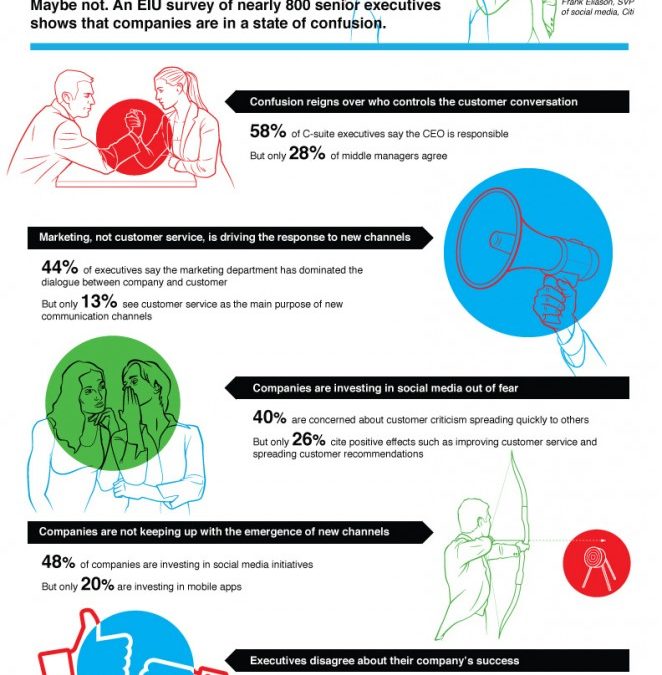Genyses along with the Economist Intelligence Unit have compiled and excellent report on the importance of making closer connections with customers a C-Suite priority. They sight several challenges which are listed below. They’ve also created a infographic depicting the findings. It’s good to find reports like this on highly reputable websites like The Economist’s EIU – for a number of years TomorrowToday has been showing business leaders the importance of building customer connections based on partnerships. You can learn more about the highly engaging presentations we run on creating customer loyalty : Herding Cats and our award winning Mind the Gap.
Getting closer to the customer – A challenge for the C-suite
An Economist Intelligence Unit report which examines how the dialogue between customers and companies has changed in response to the advent of new communication channels. The report was written by David Bolchover and edited by Annabel Symington
Social media and mobile devices are fundamentally remapping the relationship between companies and their customers. Mobile-phone penetration is over 100% in the US and western Europe and approaching 75% in Sub-Saharan Africa, according to Economist Intelligence Unit estimates. Despite a gloomy global economic outlook, our insatiable need to communicate appears to be recession-proof. The explosive demand for social media and mobile devices saw Facebook launch a US$16bn initial public offering (IPO) in May and pushed Apple’s stock price aboveUS$600 after the launch of the New iPad in March. Customer demands to be part of a dialogue with companies cannot be ignored – and top-level involvement is needed to ensure that a response to the new status quo is integrated into the way companies operate today.
Most organisations’ response to the new communication reality has so far been tentative. An Economist Intelligence Unit survey of global senior executives, sponsored by Genesys, reveals a corporate world that is still working through its initial response to this radically altered environment. Customers today expect their interactions with a brand to be more of a dialogue than a company-dominated monologue, and many of those customers prefer to use different communication channels than those most frequently found in organisations today.
The key findings from the report are as follows.
- The new communication reality has left companies in a state of flux – even confusion. The business world cannot ignore the change that has happened at the nexus of technological innovation and cultural revolution. Companies need to address the new communication landscape strategically to ensure an integrated and holistic approach.
- Most companies have placed more importance on social media than on other channels, hindering a holistic response. This focus on social media at the expense of mobile platforms raises the possibility that many companies are in reaction mode, responding as best they can to the rapid proliferation of social media, rather than developing a coherent strategy that addresses the spread of mobile technology as well.
- Marketing has dominated companies’ response to new communication channels. This has left many companies responding to customers’ comments – and complaints – on social networks rather than addressing the root cause of the problem, namely product or service complaints. A customer communication strategy that connects those talking to customers to those responsible for products or services would prevent this.
- Making a single individual responsible for managing communication channels reduces internal confusion and leads to a more coherent approach. Disagreements between the C-suite and middle management have emerged over who has ultimate responsibility for social media and mobile communication. But companies which appoint one person, rather than a team, to oversee how all communication channels are adopted and used display a more integrated approach. This helps to bridge the gap between different internal functions, namely marketing and customer service.
- Read more: http://www.managementthinking.eiu.com/getting-closer-customer.html#ixzz1z4VduAWd
- http://www.managementthinking.eiu.com/getting-closer-customer.html



